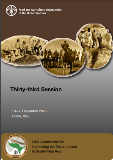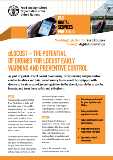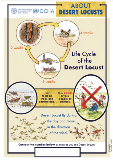Publications
In this section you can find out guidelines, documents, reports and many more publications on locusts

Desert Locust Control Committee: a global coordinating body for locust early warning and preventive control
2017
The Desert Locust, Schistocerca gregaria, is the world’s most dangerous migratory pest with a voracious appetite unmatched in the insect world. Established in 1955 by FAO, when the world was in the midst of a 12-year-long Desert Locust plague, the Desert Locust Control Committee (DLCC) is the primary forum that brings together locust-affected countries, donors and other agencies to discuss Desert Locust management under the FAO umbrella.

FAO advanced tools and technologies for locust monitoring and early warning
2016
The Desert Locust Information Service (DLIS) at FAO Headquarters continuously monitors global weather, ecological conditions and the locust situation, ensuring timely and appropriate actions.

FAO Desert Locust Information Service (DLIS) helps countries to control Desert Locust
2015
DLIS is a global early warning system, based on new advances in technologies and acting as a focal point and coordinator of a global locust information network. It can be a model for other migratory pest early warning systems throughout the world.

FAO Commission for Controlling the Desert Locust in South-West Asia (SWAC): 33rd Session report
2024
Report of the FAO Commission for Controlling the Desert Locust in South-West Asia, Thirty-third Session, held in Rome, Italy, 18-20 December 2023.

Manual for the implementation of environmental, health, and safety standards for the control of locusts
2021
The Environmental, Health and Safety (EHS) Standard Operation Procedures (SOP) for the control of the Desert Locust define the procedures that should be followed in a Desert Locust control campaign to minimize the impact of the use of insecticides on human health and the environment.

Contingency planning makes countries more resilient to locust threats and crises
2016
LOCUSTS are a serious threat to agro-pastoral resources, food security and livelihoods in Africa and Asia where they can have major economic, social and environmental impacts. Effective early response to locust infestations and their management relies on having well established and tested contingency plans before a locust emergency develops.

dLocust: the potential of drones for locust early warning and preventive control
2018
On the occasion of the conference "Youth employment in agriculture as a solid solution to ending hunger and poverty in Africa" (Kigali, Rwanda, 20−21 August 2018), FAO will showcase a digital service portfolio, consisting of 10 innovation projects.
Posters
FAO, in collaboration with OCHA, has developed six simple, easy to understand posters for communities that may be affected by Desert Locust. The purpose of these posters is to provide basic messages to communities on pesticide containers, safety measures, pesticide exposure, farmer advice, Desert Locust and following instructions. While the posters are in English, they can easily be modified to other local languages. In order to help strengthen the reporting of locusts, a contact number can be added at the bottom, which should be that of the national locust centre.






